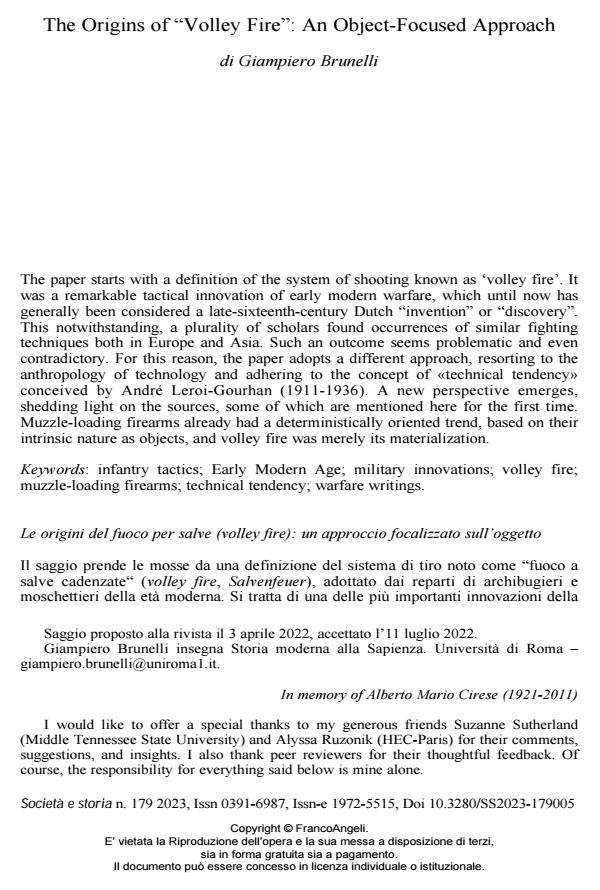The Origins of "Volley Fire": An Object-Focused Approach
Titolo Rivista SOCIETÀ E STORIA
Autori/Curatori Giampiero Brunelli
Anno di pubblicazione 2023 Fascicolo 2023/179
Lingua Inglese Numero pagine 22 P. 91-112 Dimensione file 167 KB
DOI 10.3280/SS2023-179005
Il DOI è il codice a barre della proprietà intellettuale: per saperne di più
clicca qui
Qui sotto puoi vedere in anteprima la prima pagina di questo articolo.
Se questo articolo ti interessa, lo puoi acquistare (e scaricare in formato pdf) seguendo le facili indicazioni per acquistare il download credit. Acquista Download Credits per scaricare questo Articolo in formato PDF

FrancoAngeli è membro della Publishers International Linking Association, Inc (PILA)associazione indipendente e non profit per facilitare (attraverso i servizi tecnologici implementati da CrossRef.org) l’accesso degli studiosi ai contenuti digitali nelle pubblicazioni professionali e scientifiche
The paper starts with a definition of the system of shooting known as ‘volley fire’. It was a remarkable tactical innovation of early modern warfare, which until now has generally been considered a late-sixteenth-century Dutch "invention" or "discovery". This notwithstanding, a plurality of scholars found occurrences of similar fighting techniques both in Europe and Asia. Such an outcome seems problematic and even contradictory. For this reason, the paper adopts a different approach, resorting to the anthropology of technology and adhering to the concept of «technical tendency» conceived by André Leroi-Gourhan (1911-1936). A new perspective emerges, shedding light on the sources, some of which are mentioned here for the first time. Muzzle-loading firearms already had a deterministically oriented trend, based on their intrinsic nature as objects, and volley fire was merely its materialization.
Il saggio prende le mosse da una definizione del sistema di tiro noto come "fuoco a salve cadenzate" (volley fire, Salvenfeuer), adottato dai reparti di archibugieri e moschettieri della età moderna. Si tratta di una delle più importanti innovazioni della coeva arte della guerra. Finora, esso è stato generalmente considerato una "scoperta" o un’"invenzione" olandese degli anni novanta del cinquecento, nonostante alcuni studiosi abbiano trovato precedenti occorrenze di tecniche analoghe sia in Europa, sia in Asia. Il risultato appare problematico e persino contraddittorio. Per questo motivo viene adottato un approccio diverso, ispirato all’antropologia della tecnologia, aderendo in particolare al concetto di «tendenza tecnologica» messo a punto da André Leroi-Gourhan (1911-1986). Emerge così una nuova prospettiva di interpretazione che fa luce sulle fonti, alcune delle quali vengono qui presentate per la prima volta. Le armi da fuoco ad avancarica, come oggetti, erano al centro di un trend deterministicamente orientato, basato sulla loro natura intrinseca. Il fuoco cadenzato non ne fu che la materializzazione.
Parole chiave:tattica di fanteria; prima età moderna; innovazioni militari; fuoco cadenzato; armi da fuoco ad avancarica; tendenza tecnica; scritti di arte della guerra.
Giampiero Brunelli, The Origins of "Volley Fire": An Object-Focused Approach in "SOCIETÀ E STORIA " 179/2023, pp 91-112, DOI: 10.3280/SS2023-179005